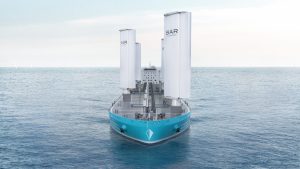Nature’s energy: harnessing the power of wind

Given our already substantial experience in new energy solutions, we are well placed to help customers explore and implement wind-assisted propulsion as the green transformation of shipping moves steadily from words to action.
At Deltamarin, we aim to be a maritime industry leader in the transition to net zero. Promoting environmental performance is at the heart of our designs and we are constantly exploring new ways to reduce fuel consumption and CO2 emissions with a strong focus on energy efficiency. Our overriding mission is to create unique solutions based on specific customer requirements that will future-proof their operations.
Auxiliary wind propulsion is very much part of that journey, with great decarbonisation potential for both newbuilds and retrofits alongside new sustainable fuels such as hydrogen, ammonia, methanol, biofuels and synthetic fuels – and maybe even safe nuclear technologies in the future.
Burgeoning market for wind solutions
The popularity of wind propulsion has grown considerably in the last few years and new wind-propulsion suppliers and solutions have entered the market in large numbers. This is great news as decarbonization evolves from theoretical pronouncements to concrete measures. However, the complexity of wind-propulsion retrofit projects should not be underestimated, and at Deltamarin we are gradually amassing a lot of experience and insight into this promising new source of energy for ships.
Figuring out the basics
The first aspect that must be clarified is the benefit of wind propulsion for a ship’s intended route(s), and both Deltamarin and several wind propulsion solution providers have good tools for evaluating this initial parameter. In reality, however, it is equally important to know how to assess the effects of wind propulsion on a ship’s operative behavior and identify practical integration aspects at an early stage. As an external expert, Deltamarin has the opportunity and ability to compare different wind-propulsion solutions and validate the calculations, not least considering aspects related to onboard integration.
For projects to be successful, it is crucial to map out entire system functionality and special features at the very beginning to see what challenges may arise and what can be done to prevent costly modifications or setbacks. The devil is often in the details, which are easily missed without a comprehensive understanding of the integration aspects.
Overcoming optimization hurdles
Wind propulsion optimization is intriguing but very challenging in practice. There are specific locations on a ship where wind propulsion can produce the maximum thrust and thereby maximum operational savings. However, we have noticed in several projects that employing the sails in such places can be less optimal both operationally and/or integration-wise. Optimization is in reality a combination of calculation and simulation, requiring in-depth understanding of the ship’s technology and its operational profile. In addition to the type of vessel and its route(s), the optimal wind-propulsion configuration is influenced by the aforementioned location factors, meaning it is impossible to says which is the best solution in general; it always depends on the specific customer case. Typically, the greater the savings sought, the more complex the project becomes in terms of integration and practical aspects. This can sometimes have a significant cost impact, making it essential to have a clear picture of the total solution cost already when comparing different options.
Effective project management is key for success
In wind-propulsion retrofit projects, various technicalities will eventually emerge making workflow management critically important due to its potentially large impact on the total cost. The number of project stakeholders increases as the installation progresses and the timelines of the different parties are interlinked. It is also important to note that the parties need initial information from each other, and the delivery of this data requires good schedule control. Understanding how shipyards operate and spotting the need to edit supplier information is also important to avoid misunderstandings down the road. This is standard project management practice, but its importance cannot be overemphasized as a prerequisite for a successful outcome.
Learning from experience
Deltamarin has been involved in more than 10 retrofit cases in the past few years and wind propulsion is increasingly being considered in new designs as well. Both we and the maritime industry in general have learned a lot and developed extensive expertise in this type of work, and the number of projects is only increasing. As in all conversions, a successful installation ultimately depends on doing proper and reliable groundwork.
Early embedding of verification plans
The coming months and years will be very interesting as several new technologies are piloted and put into use. We strongly believe that wind propulsion has a great decarbonization potential for both existing and new ships, and we look forward to assessing results from ships operating such systems. To verify the benefits, it is essential to implement a robust measurement plan already in the conversion phase.
‘One-stop shop’
Given our long heritage, at Deltamarin we are adept at managing large, complex projects both for newbuilds and conversions that involve multiple disciplines and different actors worldwide. Crucially we also ensure early on that work will be completed within the given timeframe, and we apply our expertise and experience to steer projects in the right direction from day one.
Preparing for the future
We see increasing interest to wind assisted propulsion both in conversions and newbuild designs. However, there is additional optimization potential. Existing ships and most newbuilds are still designed with hulls and propulsion that are not necessarily optimal for significant wind assistance. We are also actively working on the optimization of hull and propulsion systems to accommodate viable solutions.
We are planning to release more information of our joint optimization work with one of the leading wind propulsion manufactures on wind assisted hull forms in the coming days.

Want to read more? See also our other published blogs.
For more information, please contact
